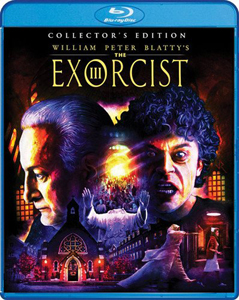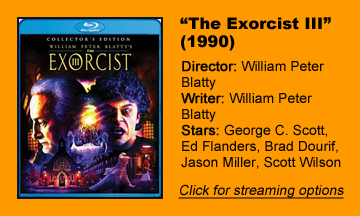It’s an excellent month for an exorcism. From Oct. 21-31, I’m looking back at the five films of “The Exorcist” series as we celebrate Spooky Month here at Reviews from My Couch. Next up is the third film, “The Exorcist III” (1990):
Crafting a scare
In one of the best sequences from “The Exorcist III,” a nurse is going about her rounds in a psychiatric ward. She had already survived a fake-out scare, but now things have settled down. The night security guard is off on his patrol elsewhere in the building and she gets back to work in a shot that’s been locked in for quite a while: We see her at a distance, from the end of a hall.
Suddenly, the killer jumps out from a cross corridor, syringe raised, accompanied by a blast of orchestral sound. Then we smash-cut to the next scene.
This third “Exorcist” film, written and directed by “Exorcist” author William Peter Blatty based on his own 1983 book sequel “Legion,” is a great dive into Christian-themed horror.
But its style is intriguingly just a bit different from the norm, while still being crafted with remarkable expertise considering this is one of only two films Blatty helmed.
The pace is very much a slow burn, and that will turn off even some folks who like similar material such as the “Conjuring” films. But in contrast to most horror pictures since, Blatty doesn’t use jump scares solely for fake-outs; he also uses them for the true attacks. He keeps a viewer feeling uneasy, leading to a movie that gets under your skin even though the scares are sparse.
A less kindly Kinderman
Blatty keeps us at a slight remove from what’s happening. Initially, the film is a character piece about police detective Kinderman (George C. Scott, taking over from Lee J. Cobb, who had a small but important part in the original). He’s a family man, but also lonely, but also thoughtful about the big topics. Yet he’s pricklier here compared to his cuddly book portrayal. Kinderman is a capital-C Character, like the lead of a TV series, someone we’d like to follow from case to case.
Even before we get to the killer, the film is populated with oddballs who leave us uneasy. Nancy Fish’s Nurse Allerton is as foreboding as “Young Frankenstein’s” Frau Blucher, and Scott Wilson’s chain-smoking Dr. Temple rehearses his interview with Kinderman; he’s perhaps more neurotic than his own patients. Aside from an oddball mother-in-law, Kinderman’s family is warm and loving, but Blatty doesn’t let us escape to that warmth.
In another odd choice, “Exorcist III” (which can be enjoyed without seeing “Exorcist II: The Heretic”) tells us about the details of the creepy serial killings rather than showing us – at least at first. Up until the aforementioned big scare, Blatty protects us from the fact that we’re watching a horror movie. But the second half is as intense as the original as we’re thrown into a more complex story of possession.
Miller time, again
If a lone actor is to return from the original, Jason Miller would seem to be an odd choice since Father Karras dies in that film. Most of Miller’s performance in “Exorcist III” is for the sake of an explanation to the baffled Kinderman about how he’s still alive.
It’s combined with Brad Dourif, as the Gemini Killer, giving a turn that will be familiar to fans of the “X-Files” episode “Beyond the Sea.” A demon is possessing Karras’ body and is able to change his visage to that of the Gemini Killer. It’s silly on paper, but Miller and Dourif sell the hell (no pun intended) out of the exposition.
Blatty’s film gives off a slight vibe of “The heck with the original film; I’m going to do what I want.” And compared to the original, I am more aware of “Exorcist III” being a book adaptation; it’s a little bit stiffer out of the gates. When Kinderman says Karras was his “best friend,” it seems Blatty is making a sequel to his “Exorcist” book rather than to the movie, where Kinderman and Karras share one scene.
The 1973 film doesn’t give us a sense that they had time to become “best friends” off screen, as Kinderman and Father Dyer (Ed Flanders, taking over from William O’Malley) now are.
Bigger shocks
That said, this feels very much like an “Exorcist” sequel. Given the directorial reins, Blatty’s style is similar to William Friedkin’s in that they both value a slow burn.
But Blatty’s shocking moments are bigger – the aforementioned psych ward scene being the standout example – and it serves the film well. “Exorcist III” loses some character depth from the source material, as also happened with Friedkin’s film and most book adaptations. Perhaps Blatty gained sympathy for the directorial job after this project.
“The Exorcist III” strikes me as something people will either love or hate, depending on whether the slow pace gets under your skin or bores you. I’m in the “love it” category. Scott’s Kinderman is a colorful yet grounded person, working a procedural job and pontificating about the meaning of it all in his spare moments.
When the events get wild, we’re braced for it. Through his style and choices of what story points to emphasize, Blatty successfully sells a narrative that’s crazier than many horror flicks we dismiss for being too silly.
Schedule of “Exorcist” reviews:
Wednesday, Oct. 21: “The Exorcist” (1973)
Friday, Oct. 23: “Exorcist II: The Heretic” (1977)
Wednesday, Oct. 28: “The Exorcist III” (1990)
Friday, Oct. 30: “Exorcist: The Beginning” (2004)
Saturday, Oct. 31: “Dominion: Prequel to The Exorcist” (2005)



